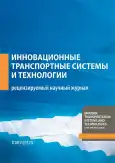Методика оценки качества кадрового потенциала проектной группы и влияние квалификации на проектные риски
- Авторы: Петроченко М.В.1
-
Учреждения:
- Санкт-Петербургский политехнический университет Петра Великого
- Выпуск: Том 11, № 1 (2025)
- Страницы: 134-151
- Раздел: Оригинальные статьи
- URL: https://bakhtiniada.ru/transj/article/view/289348
- DOI: https://doi.org/10.17816/transsyst642802
- ID: 289348
Цитировать
Полный текст
Аннотация
Цель. Разработка методики оценки качества кадрового потенциала проектной группы и прогнозирования влияния уровня профессиональной подготовленности специалистов на технико-экономические показатели и инжиниринговые риски безопасной эксплуатации планируемых к строительству транспортных сооружений.
Материалы и методы. Качество проектов транспортных сооружений определяется применением инновационных технических и технологических решений, конструкционных материалов и зависит от уровня квалификации специалистов проектных групп. В основу методики оценки качества кадрового потенциала проектной группы положено допущение о том, что квалификация проектировщика является латентной (скрытой переменной), зависящей от присущих специалисту квалификационных признаков. Количественные характеристики признаков являются случайными величинами. В связи с этим, показатели качества разрабатываемых проектов имеют вероятностный характер, что требует анализа рисков возникновения проектных (инжиниринговых) ошибок. Для оценки квалификации специалистов и ее влияния на технико-экономические показатели проектов предлагается использовать наряду с общеметодологическими принципами теории квалиметрии, методы многокритериального и статистического анализа. Количественные характеристики квалификационных признаков (их математические ожидания) объединяются в интегральный показатель квалификации посредством комплексного использования математических методов мультиаддитивной и мультипликативной свертки.
Результаты. Получена аналитическая модель уровня квалификации специалиста, учитывающая влияние на обобщенный показатель качества как взаимозависимых, так и независимых частных показателей профессиональной подготовленности.
Заключение. Проблема профессиональной подготовки кадров в наибольшей степени проявляется на стадии проектирования транспортных сооружений. В проекте закладываются основные свойства безопасности, надежности, экономичности и другие транспортно-эксплуатационные и технико-экономические показатели качества объектов транспортного строительства. Предложенная методика позволяет выявить функциональные соотношения между качеством кадрового потенциала проектной организации и уровнем качества проектных решений. Полученные при разработке методики функциональные соотношения позволяют оценить влияние квалификации на проектные риски и обеспечить возможность подбора кадрового состава, а также разработки мероприятий по повышению квалификации имеющихся специалистов.
Полный текст
Открыть статью на сайте журналаОб авторах
Марина Вячеславовна Петроченко
Санкт-Петербургский политехнический университет Петра Великого
Автор, ответственный за переписку.
Email: petrochenko_mv@spbstu.ru
ORCID iD: 0000-0002-4865-5319
SPIN-код: 6869-0011
кандидат технических наук, доцент
Россия, Санкт-ПетербургСписок литературы
- Azhmukhamedov AI, Protalinsky OM. Personnel Management of Project Oriented Organizations under Uncertainty. Transactions TSTU. 2013;19(4):771–782. (In Russ.) EDN: RSXNRV
- Ahmed AR, Yermoshin NA. Optimum design of cable-stayed bridges considering cable loss scenarios. Asian Journal of Civil Engineering. 2024;25(3):2801–2809. doi: 10.1007/s42107-023-00946-1. EDN: GPKVQX
- Rybakova AA, Lyaskovskaya EA. Personnel management of constructionorganizations. Electronic scientific & practical journal “Economics and innovations management”. 2016;(6). (In Russ.) EDN: WMKZNR
- Manichev SA. Problems of application of biographic questionnaires in personnel selection. Vestnik Sankt-Peterburgskogo universiteta. Seriya 12. Psikhologiya. Sotsiologiya. Pedagogika. 2009;(3-2):238–245. (In Russ.) EDN: MBVZIR
- Shakhgiraev IU, Rakhimova BK. Enterprise personnel potential management and evaluation methods. Regional’nye problemy preobrazovanija jekonomiki. 2020;5(115):116–122. (In Russ.) doi: 10.26726/1812-7096-2020-04-116-122. EDN: WPFBUG
- Murashkin NV. The mathematical modeling of recruitment. The Scientific Journal “Modeling, Optimization and Information Technology”. 2017;1(16):13. (In Russ.) EDN: YMAFFN
- Sudakova ES. Assessment of personnel labor potential: approaches, methods, methodology. The Eurasian Scientific Journal. 2014;4(23). (In Russ.) EDN: TCFNHD
- Petrichenko GS, Kritskaya LM, Petrichenko DG. Methodology of estimation of the competence of candidates at selection to vacant stand. Belgorod State University Scientific Bulletin. Economics Information technologies. 2019;46(1):130–137. (In Russ.) doi: 10.18413/2411-3808-2019-46-1-130-137. EDN: AFWZJI
- Zhdanov VY. Development of coefficient-point model for personnel assessment. Industrial Economy. 2022;2(2):116–120. (In Russ.) doi: 10.47576/2712-7559_2022_2_2_116. EDN: TUOPTV
- Marshirova LE, Marshirov VV. Algorithms of employee motivation and performance appraisal in project activities. Economic Analysis: Theory and Practice. 2016;(12):187–196. (In Russ.) EDN: XESGGH
- Baturin NA, Vuchetich YV, Kostromina SN, et al. Russian Standard for Personnel Testing. Organizational Psychology. 2015;5(2):67–138. (In Russ.) EDN: UKQHZV
- Nikitenkova OV. Primeneniye matematicheskogo modelirovaniya pri formirovanii kadrovogo potentsiala predpriyatiya. In: INNOVATSII: BIZNES. OBRAZOVANIY. Materialy mezhdunarodnoy nauchnoprakticheskoy konferentsii. Smolenskiy institut biznesa i predprinimatel’stva; nov. 21-22, 2013; editor Grushenko VI. Kirov: MCNIP; 2014:71–89. (In Russ.) EDN: SIBQGP
- Chudnova OV. Personnel self-assessment as a way to increase labor efficiency. Humanitarian Scientific Bulletin. 2020;(3):123–126. (In Russ.) doi: 10.5281/zenodo.3764122. EDN: DKHDSU
- Afanasyev VY, Vorontsov NV, Baykova OV. Analysis and assessment of personnel capacity of the organization’s staff at present stage. Vestnik Universiteta. 2020;(7):5–13. (In Russ.) doi: 10.26425/1816-4277-2020-7-5-13
- Maksimova LV, Shoinkhorova VR, Maksimov IS. Assessment methods of HR potential of employees in industrial and service companies. The bulletin of the Far Eastern Federal University. Economics and Management. 2018;(1):90–101. (In Russ.) doi: 10.24866/2311-2271/2018-1/90-101
- Uryngaliyeva AA. The use of business games for assessing the quality of placement. The Eurasian Scientific Journal. 2017;9(5):56. (In Russ.) EDN: YKWGSU
- Zonova PO, Penskiy OG. O matematicheskoy otsenke velichiny dostizheniya postavlennoy tseli. Bulletin of Perm University. Mathematics. Mechanics. Computer Science. 2009;(3):53–57. (In Russ.) EDN: KHNUQX
- Nikolaev MV. Evaluation of the 360 degrees in an organization’s HR system. Economics: Yesterday, Today and Tomorrow. 2022;12(8A):287–296. (In Russ.) doi: 10.34670/AR.2022.11.10.035
- Evplova YV, Matveeva PA, Mateev VV, et al. High-class employess assessment system. Azimuth of Scientific Research: Economics and Administration. 2019;8(4):146–150. (In Russ.) doi: 10.26140/anie-2019-0804-0030
- Nosyreva IG, Moskvitina NV. Functional and cost analysis as a tool for improving the personnel management system in the budgetary educational institution of higher education. Russian Journal of Labor Economics. 2019;6(2):971–990. (In Russ.) doi: 10.18334/et.6.2.40597 EDN: LHNHTJ
- Ryabchuk PG, Fedorova KA, Apukhtin AS, Pluzhnikova II. Analysis of modern methods evaluation of staff potential. Upravleniye ekonomicheskimi sistemami: elektronnyy nauchnyy zhurnal. 2017;(9):18. (In Russ.) EDN: ZGZRYH
- Manoharan K, Dissanayake P, Pathirana C, et al. A Constructive System to Assess the Performance based Grading of Construction Labour through Work-Based Training Components and Applications. Construction Economics and Building. 2023;23(3/4):107–124. https://doi.org/10.5130/AJCEB.v23i1/2.8390
Дополнительные файлы








